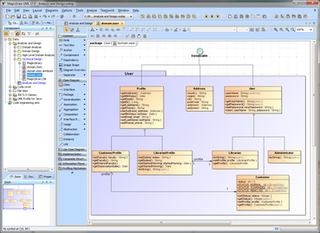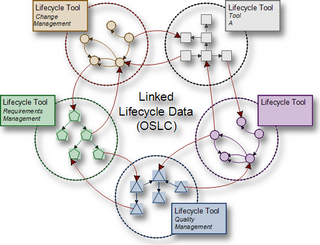Related Research Articles
The XML Metadata Interchange (XMI) is an Object Management Group (OMG) standard for exchanging metadata information via Extensible Markup Language (XML).
A platform-independent model (PIM) in software engineering is a model of a software system or business system that is independent of the specific technological platform used to implement it.
Astah, formerly known as JUDE, is a UML modeling tool created by Japanese company Change Vision. JUDE received the "Software Product Of The Year 2006" prize, established by Information-Technology Promotion Agency in Japan.
Model-driven engineering (MDE) is a software development methodology that focuses on creating and exploiting domain models, which are conceptual models of all the topics related to a specific problem. Hence, it highlights and aims at abstract representations of the knowledge and activities that govern a particular application domain, rather than the computing concepts.

The systems modeling language (SysML) is a general-purpose modeling language for systems engineering applications. It supports the specification, analysis, design, verification and validation of a broad range of systems and systems-of-systems.

MagicDraw is a proprietary visual UML, SysML, BPMN, and UPDM modeling tool with team collaboration support.

Papyrus is an open-source UML 2 tool based on Eclipse and licensed under the EPL. It has been developed by the Laboratory of Model Driven Engineering for Embedded Systems (LISE) which is a part of the French Alternative Energies and Atomic Energy Commission (CEA-List).
EAST-ADL is an Architecture Description Language (ADL) for automotive embedded systems, developed in several European research projects. It is designed to complement AUTOSAR with descriptions at higher level of abstractions. Aspects covered by EAST-ADL include vehicle features, functions, requirements, variability, software components, hardware components and communication. Currently, it is maintained by the EAST-ADL Association in cooperation with the European FP7 MAENAD project.

UModel is a UML software modeling tool from Altova, the creator of XMLSpy. UModel supports all 14 UML 2 diagram types and adds a unique diagram for modeling XML Schemas in UML. UModel also supports SysML for embedded system developers, and business process modeling for enterprise analysts. UModel includes code engineering functionality including code generation in Java, C#, and Visual Basic, reverse engineering of existing applications, and round-trip engineering.

Open Services for Lifecycle Collaboration (OSLC) is an open community, originally proposed in 2008, to define a set of specifications that enable integration of software development. It has evolved, and continues to evolve, to areas such as Application Lifecycle Management (ALM), Product Lifecycle Management (PLM), IT Operations and more. The intention is to make life easier for tools users and tools vendors, by making it easier for tools to work together.

Modelio is an open-source UML tool developed by Modeliosoft, based in Paris, France. It supports the UML2 and BPMN standards.
The Open Control Architecture (OCA) is a communications protocol architecture for control, monitoring, and connection management of networked audio and video devices. Such networks are referred to as "media networks".
Eclipse Deeplearning4j is a programming library written in Java for the Java virtual machine (JVM). It is a framework with wide support for deep learning algorithms. Deeplearning4j includes implementations of the restricted Boltzmann machine, deep belief net, deep autoencoder, stacked denoising autoencoder and recursive neural tensor network, word2vec, doc2vec, and GloVe. These algorithms all include distributed parallel versions that integrate with Apache Hadoop and Spark.

Sparx Systems Enterprise Architect is a visual modeling and design tool based on the OMG UML. The platform supports: the design and construction of software systems; modeling business processes; and modeling industry based domains. It is used by businesses and organizations to not only model the architecture of their systems, but to process the implementation of these models across the full application development life-cycle.
Model-based systems engineering (MBSE), according to the International Council on Systems Engineering (INCOSE), is the formalized application of modeling to support system requirements, design, analysis, verification and validation activities beginning in the conceptual design phase and continuing throughout development and later life cycle phases. MBSE is a technical approach to systems engineering that focuses on creating and exploiting domain models as the primary means of information exchange, rather than on document-based information exchange. MBSE technical approaches are commonly applied to a wide range of industries with complex systems, such as aerospace, defense, rail, automotive, manufacturing, etc.

Capella is an open-source solution for model-based systems engineering (MBSE). Hosted at polarsys.org, this solution provides a process and tooling for graphical modeling of systems, hardware or software architectures, in accordance with the principles and recommendations defined by the Arcadia method. Capella is an initiative of PolarSys, one of several Eclipse Foundation working groups.
References
- ↑ "Contact Us". Astah. Archived from the original on 10 August 2020. Retrieved 2 August 2020.
- ↑ "Astah SysML Release Notes". Astah. Archived from the original on 4 August 2021. Retrieved 29 July 2021.
- ↑ "History - Capella 0.8.1". Eclipse Foundation. Archived from the original on 28 January 2021. Retrieved 20 January 2021.
- ↑ "History - Capella 5.0.0". Eclipse Foundation. Archived from the original on 16 December 2020. Retrieved 20 January 2021.
- ↑ "source code". Github. Archived from the original on 2020-12-16. Retrieved 2021-01-20.
- ↑ "Concept Draw - Press Releases". CS Odessa. Archived from the original on 26 October 2020. Retrieved 2 August 2020.
- ↑ "History - Enterprise Architecture". Sparx Systems. Archived from the original on 17 August 2020. Retrieved 2 August 2020.
- ↑ See https://github.com/gaphor/gaphor
- ↑ https://gaphor.org/, https://pypi.org/project/gaphor/
- ↑ "Contact Us". SPEC Innovations. Archived from the original on 26 May 2021. Retrieved 25 May 2021.
- ↑ "Innoslate Release Notes". Innoslate. Archived from the original on 26 May 2021. Retrieved 26 May 2021.
- ↑ "MagicDraw". No Magic, Inc. System requirements. Archived from the original on 4 July 2022. Retrieved 4 July 2022.
- ↑ "MagicDraw". nomagic.com. No Magic, Inc. 2022x Version News. Archived from the original on 4 July 2022. Retrieved 4 July 2022.
- ↑ "ModelioOpenSource/Modelio (GitHub)". www.modelio.org. Archived from the original on 23 February 2023. Retrieved 4 March 2023.
- ↑ "Modeling open source licensing". Modelio Open Source. Archived from the original on 2021-04-17. Retrieved 2020-08-29.
- ↑ "Find source code". Modelio Open Source. Archived from the original on 2017-10-28. Retrieved 2020-08-29.
- ↑ "Papyrus Downloads". eclipse.org. Archived from the original on 27 June 2020. Retrieved 2 August 2020.
- ↑ "What's New in UModel". Altova. Archived from the original on 26 September 2020. Retrieved 3 August 2020.
- ↑ "News Releases". Visual Paradigm. Archived from the original on 3 October 2020. Retrieved 2 August 2020.
- ↑ "XMI Import/Export". Archived from the original on 4 August 2021. Retrieved 29 July 2021.
- ↑ "Equivalences and differences between SysML and Arcadia/Capella". Archived from the original on 29 November 2020. Retrieved 20 January 2021.
- ↑ "M2Doc for Capella". Archived from the original on 27 January 2021. Retrieved 20 January 2021.
- ↑ "Publication for Capella". Archived from the original on 3 December 2020. Retrieved 20 January 2021.
- ↑ "Polarion". Archived from the original on 23 January 2021. Retrieved 20 January 2021.
- ↑ "Webinar about Publication for Capella with Polarion". YouTube . Archived from the original on 28 January 2021. Retrieved 20 January 2021.
- ↑ "System Modeling Workbench (SMW)". Archived from the original on 27 January 2021. Retrieved 20 January 2021.
- ↑ "XMI Import and Export | Enterprise Architect User Guide". sparxsystems.com. Archived from the original on 2020-09-25. Retrieved 2020-08-15.
- ↑ "Generate Documentation | Enterprise Architect User Guide". sparxsystems.com. Archived from the original on 2020-09-20. Retrieved 2020-08-15.
- ↑ "OSLC Architecture Management V2.0". Sparx Systems. Archived from the original on 30 November 2020. Retrieved 8 August 2020.
- ↑ "MDG Link for DOORS | Sparx Systems". sparxsystems.com. Archived from the original on 2021-01-20. Retrieved 2020-08-15.
- ↑ https://docs.gaphor.org/en/latest/models/sysml.html
- ↑ https://www.sphinx-doc.org/en/master/
- ↑ https://jupyter.org/
- ↑ "SysML Diagrams | Innoslate Help Center". Archived from the original on 2021-01-26. Retrieved 2021-05-26.
- ↑ "Importing UML/SysML (xmi) Files | Innoslate Help Center". Archived from the original on 2021-01-27. Retrieved 2021-05-26.
- ↑ "Release Notes Summary | Innoslate Help Center". Archived from the original on 2021-05-26. Retrieved 2021-05-26.
- ↑ "Working with OSLC features". No Magic. Retrieved 8 August 2020.
- ↑ "Getting started". No Magic. Retrieved 8 August 2020.
- ↑ "Teamcenter Integration Plugin Documentation". No Magic. Archived from the original on 28 September 2020. Retrieved 8 August 2020.
- ↑ "Modelio features in detail". Archived from the original on 24 July 2016. Retrieved 14 August 2020.
- ↑ "Document generation". Modeliosoft. Archived from the original on 2020-09-25. Retrieved 2020-08-15.
- ↑ "Overview of Rhapsody Model Manager". IBM. 25 June 2020. Archived from the original on 17 October 2021. Retrieved 8 August 2020.